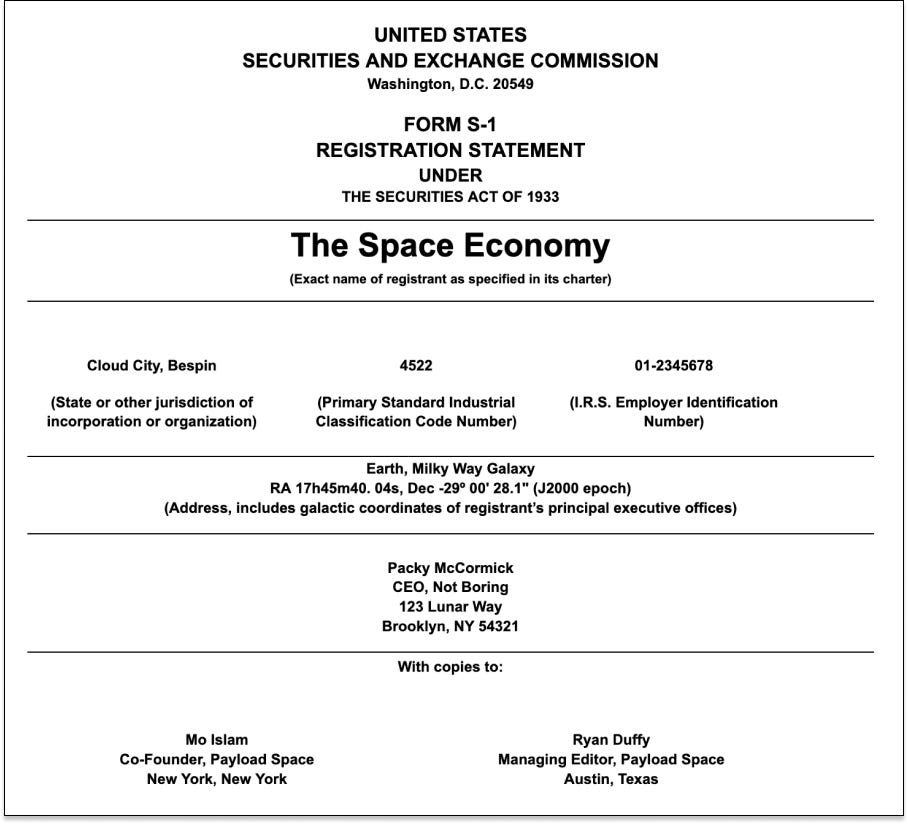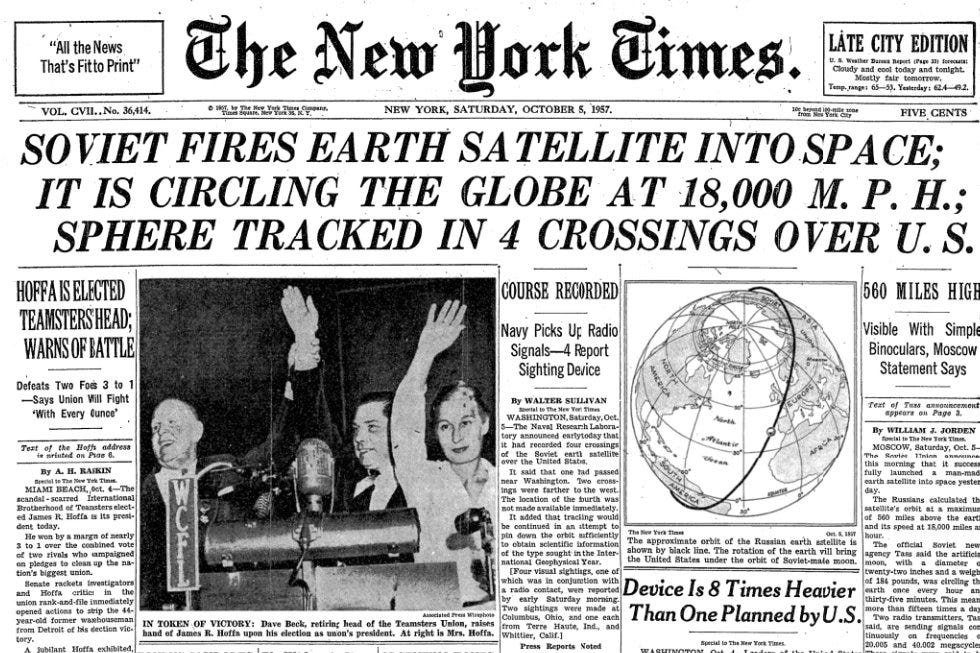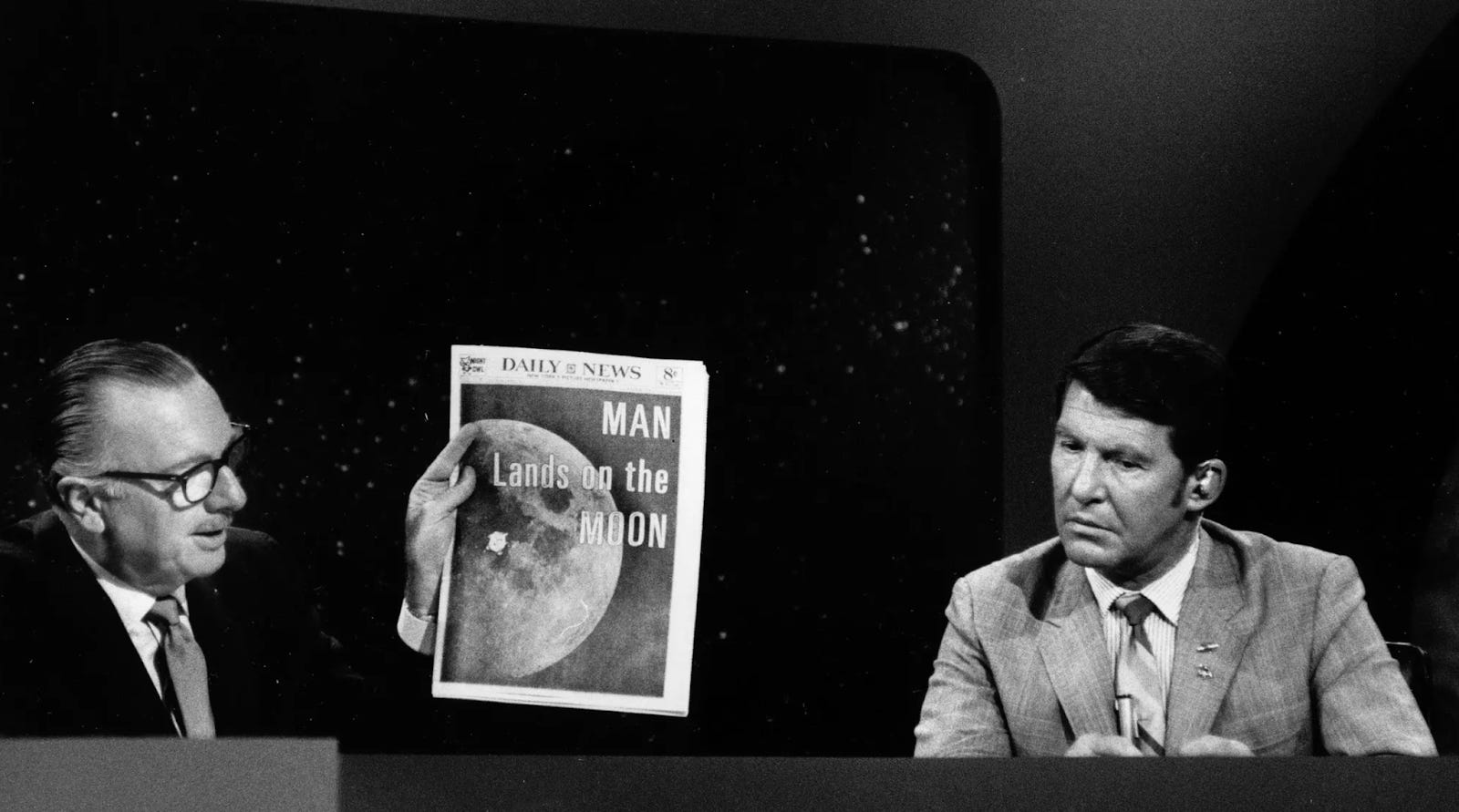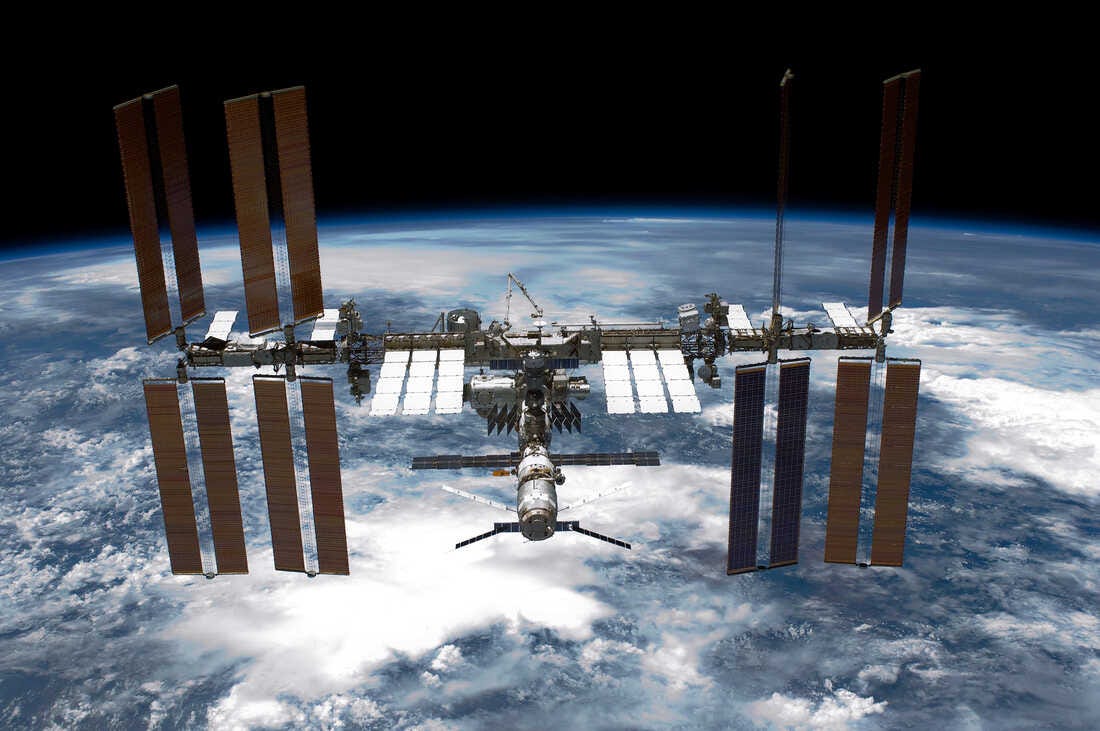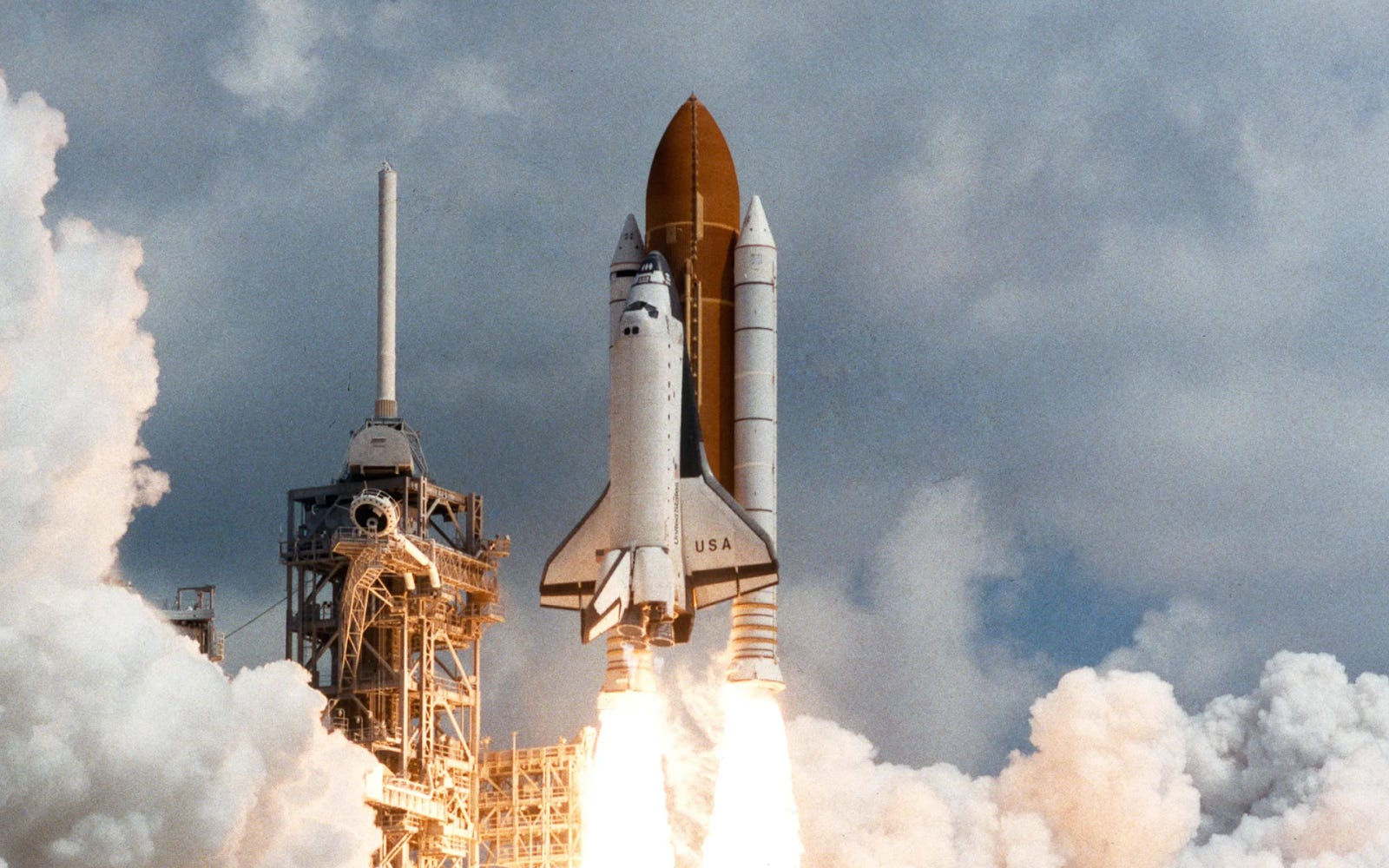Not Boring by Packy McCormick - The Space Economy
Welcome to the 1,582 newly Not Boring people who have joined us since last Monday! If you haven’t subscribed, join 145,467 smart, curious folks by subscribing here: Today’s Not Boring is brought to you by… WorkOS Building for the enterprise is typically complex, time-consuming, and distracting. Deals sometimes slip away due to strict requirements and technological demands from IT admins. With WorkOS, startups can sell to large enterprise customers from day one. It’s a set of building blocks for quickly adding features like Single Sign-On (SAML), Directory Sync (SCIM), and Multi-Factor Authentication (MFA) with just a few lines of code. Fast-growing B2B SaaS companies like Loom, PlanetScale, Airbase, and many others use WorkOS to abstract the integrations between dozens of identity providers. Webflow uses WorkOS to serve customers like Zendesk. Vercel leverages WorkOS to land enterprise customers like The Washington Post. WorkOS is an API that increases your TAM. It’s free to get started and scales with you as you grow. Hi friends 👋, Happy Monday! Big news over here at Not Boring HQ: our daughter, Maya, was born last weekend! 🥳 Mom and baby are healthy and happy, and we’re enjoying the time together as a family. The plan for my month of paternity leave is to bring in guest writers each week who are experts in areas that I think are going to be deeply important. Last week, we had Kevin Miao join to talk about securitization on the blockchain. Today, we’re bringing in the space cadets from Payload Space for an incredibly deep dive on the space economy, in the form of an S-1 for the industry. They nailed it. I was giddy reading the draft that Mo Islam and Ryan Duffy sent over this week. We’ve touched on space a little bit in Not Boring, and we’ve invested in space companies like Varda and Hadrian (see deep dive), but I don’t know nearly as much as I want to about all of the progress going on in the industry. Space sounds like futuristic sci-fi, and if you’re not familiar, it’s hard to believe how vibrant and multi-faceted the space economy is today. Plus, one of the things I’m most jealous of Dev and Maya about is that they’re almost certainly going to get to travel to space in their lifetimes. As a responsible parent, I want to know what they’re getting into. There’s no one better at covering space than the Payload team. It’s what industry insiders read, and how I’m trying to get up to speed myself, and I’m pumped that they agreed to write a Not Boring-style deep dive for us. If you’re at all interested in the … space … and want to stay up-to-date, you need to subscribe to Payload. 5…4…3…2…1… Let’s get to it. The Space Economy(Read Full Breakdown Online)TABLE OF CONTENTS
PROSPECTUS SUMMARYHere at Payload, we try to be very judicious and sparing with our use of space clichés. We’re a B2B and B2G publisher writing for the shot-callers of space. They do not want to read a half-baked joke that “actually, this is rocket science.” They’ve heard it before. It doesn’t fly. But today, dear readers, Payload is temporarily parting with our time-worn tradition in this prospectus summary and we’re going to let the clichés rip. A new space age is upon us, characterized by fierce competition between superpowers and startups alike. Dozens of space unicorns are hitting escape velocity. Finally, unlike crypto, we actually are going to the Moon. Very soon. We’re living through an age of historic firsts and massive developments, good and bad, that are happening daily in space. Just in the last few weeks, we’ve tracked the following in our daily newsletter:
There’s plenty more where that came from. In this essay, we’ll tell you everything you need to know about how we got here and where we’re headed. Payload was founded on the premise that the space industry is at an inflection point. What was once monopolized by superpowers is now being privatized, with companies taking greater share of low-Earth orbit, rocket launches, and more. So, because we passionately believe in this inflection point thesis, we’ve packaged this new space primer as an S-1. It’s an intellectual exercise unpacking what taking the space industry, broadly speaking, public. Is it tech-growth stage? Yes. Is it profitable? Ehhhhh. What else do you need to know? Well, let’s dive in… MARKET, INDUSTRY AND OTHER DATASpace: A brief historyOn Oct. 4, 1957, the Soviets launched the first artificial satellite into space. The soccer ball-sized spacecraft was named Sputnik. That word, we think, went to become one of the most famous Russian words in non-Russian tongues and English-language history books. The “Sputnik crisis” caught the West completely by surprise, clearly dividing history and the Cold War into two separate eras: “pre-Sputnik” and “post-Sputnik.” Perceptions are everything. The New York Times had a rare three-fold headliner story on the Soviets’ successful launch. Paranoia set in among American policymakers and the general public awakened to the space age. Post-Sputnik, the perception of a Pax Americana and pacing Soviet Union gave way to a public view that the Soviets had achieved a step change not just in space. The Soviets were running up a “technology gap” over the Americans. The race was on, with the two superpowers’ space programs kicking off a new front in the Cold War and one of the greatest technological showdowns of modern history. Less than one month after Sputnik 1, the Soviets sent a ~1,120 lb. satellite into Earth orbit with radio transmitters, a thermal control unit, sealed cabin, and a husky-spitz mut named Laika. The Soviets hadn’t build any Earth return capabilities into Sputnik 2, so sadly, Laika didn’t make it 😓. The pressure was on the Eisenhower administration: do something! The US delivered with Explorer 1, the Americans’ first satellite, successfully launched into space on Jan. 31, 1958, a full 119 days after the Soviets. Explorer 1 was the size of a beach ball (note: Payload only uses Earth sports balls as a metric unit for spacecraft management). Still, congressional leaders felt that space deserved more of a federal focus–and Eisenhower established NASA in 1958 and abolished NACA (the agency’s predecessor, started in 1915). NASA’s charter was to exercise “control over aeronautical and space activities sponsored by the United States.” NASA was to handle civilian space efforts, but the Pentagon still had authority over military space programs. Over the next three years, the Soviets and Americans worked on their space programs, but on April 12, 1961, it was the Soviets who sent the first person to space: Russian Lt. Yuri Gagarin. Mercury-era astronaut Alan Shepard became the first American to reach space (sub-orbitally) less than a month later, on May 5, 1961. That same year, JFK set forth a national goal: “Landing a man on the moon and returning him safely to Earth within a decade.” The Americans, it should come as no surprise, were able to meet this ambitious call less than a decade later, with Neil Armstrong taking “one small step” but a “giant leap for mankind” on July 20, 1969 (nice). As Tom Wolfe expertly chronicled in The Right Stuff, Air Force test pilots who were flying planes with rockets strapped on them in the desert would become the US’s first astronauts (part of the Mercury program). The Apollo era, though, was a high watermark for the US space program, no matter how you slice it. Astronauts were living legends and international celebrities. They drove (or, more accurately, raced) Corvettes across town in Houston. Life magazine struck a deal with the astronauts and their families to tell their stories (albeit carefully overseen by NASA handlers). After the historic Apollo 11, the US would go on to send an additional five manned missions –Apollos 12, 14, 15, 16, and 17– and 11 men to the moon and back. Since December 19, 1972, no humans have been back to the lunar surface. Winning the race to the Moon and inventing countless technologies out of thin air–all while using less processing power for the whole mission than an iPhone uses today–came at astronomical expense. Going to the Moon cost $283B, according to one tally. In relative terms, NASA's budget peaked from 1964 to 1966, when it consumed ~4% of all US federal government spend. That number now sits an order of magnitude lower at 0.4%. That’s not to say that space activity dropped in the ‘70s. Companies began to launch communications satellites to carry voice, data, and eventually, TV. In 1973, the Pentagon kicked off the Global Positioning System (GPS) project. The project would take two decades to complete, with a prototype GPS bird going up 22,000+ miles above Earth in 1978 and the full constellation coming online in the mid ‘90s. All the while, interstellar robotic probes pushed further out into the cosmos. In 1971, an American spacecraft became the first to orbit another planet (Mars). The next year, the Soviets made history by landing a spacecraft on Mars (the soft landing wasn’t so soft, as video transmission ceased from the craft after 20 seconds). They later landed not-so-softly on Venus, too. By the end of the 1970s, the US’s Voyager 1 and 2 spacecraft had sent back stunning photos of Jupiter and Saturn. The Voyagers journeyed to Neptune and Uranus (no really). SPACE STATIONThe Soviets launched the world’s first space station–Salyut 1–into low-Earth orbit (LEO) in 1971. The Soyuz 11 crew stayed aboard Salyut 1, but were killed by asphyxia due to valve failure right before reentering Earth’s atmosphere. The Salyut program would see a total of six stations launched–four for scientific research and two for military reconnaissance. The US launched its first space station–Skylab–between 1973 and 1974. Three crews occupied Skylab for ~24 weeks, and though the microgravity lab and Earth-observing workshop was meant to last nine years, it quickly lost altitude and ultimately ended as a failure. Skylab reentered Earth’s atmosphere, and as it disintegrated, cast debris across rural regions of western Australia and into the Indian Ocean. At least nobody died? Skylab and Salyut walked so that the International Space Station (ISS) could run. Jointly operated by the US, Russia, Europe, Canada, and Japan, the ISS is one of the top engineering feats of the modern age. It’s been continuously occupied since 1998, longer than tens of thousands of you reading this have been alive. Right now, as you’re reading this, there are seven people on the ISS: three Russian cosmonauts, three NASA astronauts, and one European Space Agency astronaut. The ISS is also one of the most expensive things humans have ever built, at a cost of $150 billion (the $50 billion shuttle program is typically included in the cost of the ISS as it is here). The US footed most of the bill, and NASA shells out ~$3.1 billion a year to keep things running. All good things must come to an end, and the ISS is showing its age. The station is expected to be decommissioned and deorbited into a spacecraft graveyard in the South Pacific Ocean Uninhabited Area at the end of this decade. SPACE SHUTTLEReusability is all the rage in rocket jock circles these days, but the concept is not new. You may very well have grown up watching Space Shuttle flights. The iconic vehicle was envisioned as a revolutionary transportation system that would usher in reliable, “cheap” (or cost-effective) transit to and from LEO. The spacecraft was reusable (though the boosters that launched it were not). Reusability was a key selling point. The shuttle became the American space program’s workhorse, and across three decades, the fleet of Columbia, Challenger, Discovery, Atlantis, and Endeavour flew 135 missions and 355 humans to space. But the Shuttle never lived up to its dreams, and by one estimate, cost ~$1B per head to transport astronauts to the International Space Station and back. Tragically, two crews and 14 lives were also lost on the Shuttle. The Obama administration pulled the plug on the government-run program and the Shuttle flew its final flight in June 2011. Despite the program’s budget overruns and abject dangers, the Shuttle’s final mission was an emotional moment for the nation, NASA’s rank-and-file, space buffs, and astronauts alike. After that, Washington paid Roscosmos, Russia’s space agency, to take its crews to the space station aboard Soyuz rockets. Keep Reading Online for a full breakdown of the space industry today:Thanks to Ryan and Mo for the deep dive into space, Rahul for making it happen, and Dan for editing! Subscribe to Payload Space to get the latest insights on the space industry. That’s all for today, we’ll see you Friday morning for a Weekly Dose of Optimism! Thanks for reading, Packy If you liked this post from Not Boring by Packy McCormick, why not share it? |
Older messages
Weekly Dose of Optimism #7
Friday, August 12, 2022
Moderna, Reddit Herpes, Carbon Capture, Serena, and Technological Stagnation?
Everything is Broken
Monday, August 8, 2022
Kevin Miao explains a very real crypto use case: fixing the $14T securitization market
Weekly Dose of Optimism #6
Friday, August 5, 2022
Mini Nuclear Reactors, CHIPs, 1000000x Engineers, Alzheimer's and Undead Pigs
The ABCs of Bravado
Thursday, August 4, 2022
Building a Community-First Business to Elevate Sales
Go Fork Yourself
Monday, August 1, 2022
Internet-Native Evolutionary Governance with David Phelps & Luca Prosperi
You Might Also Like
Amazon Reveals It Had 20.93 Billion Searches in December - CrewReview
Friday, February 28, 2025
You're an Amazon whiz... but maybe not an email whiz. Omnisend makes setting up email for your brand as easy as click, drag, and drop. Make email marketing easy. Hey Reader, Believe it or not,
How AI Search Handles Citations, Google’s Latest Lawsuit + 2 Weird Niche Sites
Friday, February 28, 2025
It's Friday and that means one thing... ͏ ͏ ͏ ͏ ͏ ͏ ͏ ͏ ͏ ͏ ͏ ͏ ͏ ͏ ͏ ͏ ͏ ͏ ͏ ͏ ͏ ͏ ͏ ͏ ͏ ͏ ͏ ͏ ͏ ͏ ͏ ͏ ͏ ͏ ͏ ͏ ͏ ͏ ͏ ͏ ͏ ͏ ͏ ͏ ͏ ͏ ͏ ͏ ͏ ͏ ͏ ͏ ͏ ͏ ͏ ͏ ͏ ͏ ͏ ͏ ͏ ͏ ͏ ͏ ͏ ͏ ͏ ͏ ͏ ͏ ͏ ͏ ͏ ͏ ͏ ͏ ͏ ͏ ͏
Social care strategy, ads scaling tips, background carousels, and more
Friday, February 28, 2025
Today's Guide to the Marketing Jungle from Social Media Examiner... presented by social-media-marketing-world-logo The weekend is almost here, Reader! Before you unplug, here's one last round
Bitcoin industry insiders aren’t worried about the price correction
Friday, February 28, 2025
Today's letter features a guest post from Phil Rosen, the co-founder of Opening Bell Daily, an independent financial media company. ͏ ͏ ͏ ͏ ͏ ͏ ͏ ͏ ͏ ͏ ͏ ͏ ͏ ͏ ͏ ͏ ͏ ͏ ͏ ͏ ͏ ͏ ͏ ͏ ͏ ͏ ͏ ͏ ͏ ͏ ͏ ͏ ͏
OpenAI’s underestimated us!
Friday, February 28, 2025
Altman admits they ran out of GPUs—what now?
Influence Weekly #378 - YouTube Star MrBeast Is Raising Money at a $5 Billion Valuation
Friday, February 28, 2025
GTA Developer Explores Partnerships With Metaverse Creators To Transform Popular Game Into UGC Creative Hub
Weekly Dose of Optimism #133
Friday, February 28, 2025
Pancreatic Cancer Vaccine, Restoring Hearing, Loyal, Atlas, Apple, Coinbase, Lunar Landers ͏ ͏ ͏ ͏ ͏ ͏ ͏ ͏ ͏ ͏ ͏ ͏ ͏ ͏ ͏ ͏ ͏ ͏ ͏ ͏ ͏ ͏ ͏ ͏ ͏ ͏ ͏ ͏ ͏ ͏ ͏ ͏ ͏ ͏ ͏ ͏ ͏ ͏ ͏ ͏ ͏ ͏ ͏ ͏ ͏ ͏ ͏ ͏ ͏ ͏ ͏ ͏ ͏ ͏ ͏
VC valuations feel the pressure
Friday, February 28, 2025
AI prompts record VC funding; Kindred Ventures' Steve Jang on AI wearables; Stripe hits $91.5B valuation Read online | Don't want to receive these emails? Manage your subscription. Log in The
Standing on the other side of goodbye
Friday, February 28, 2025
Little moments that make me question: have I moved away or come home? ͏ ͏ ͏ ͏ ͏ ͏ ͏ ͏ ͏ ͏ ͏ ͏ ͏ ͏ ͏ ͏ ͏ ͏ ͏ ͏ ͏ ͏ ͏ ͏ ͏ ͏ ͏ ͏ ͏ ͏ ͏ ͏ ͏ ͏ ͏ ͏ ͏ ͏ ͏ ͏ ͏ ͏ ͏ ͏ ͏ ͏ ͏ ͏ ͏ ͏ ͏ ͏ ͏ ͏ ͏ ͏ ͏ ͏ ͏ ͏ ͏ ͏ ͏ ͏ ͏ ͏
A New EBITDA Adjustment to Drive Business Selling Price (a short video)
Friday, February 28, 2025
THE EXIT STRATEGIST A New EBITDA Adjustment to Drive Business Selling Price (a short video) Click Here to Watch Our Short Video The Key to driving strategic value in the sale of a technology company is
